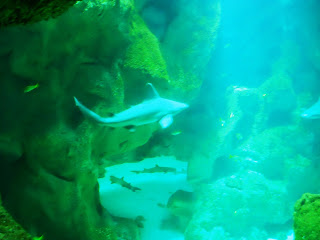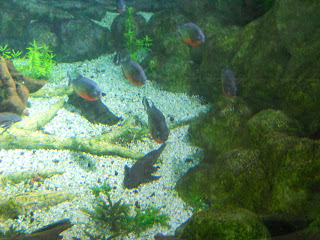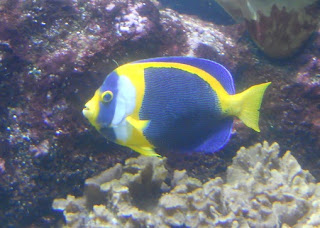The anemones are closely related to jellyfish with reticent tentacles to paralyses their prey. Some animals, such as fish and crustaceans, use this reticent power to their advantage. They maintain a symbiotic relation with the anemones that is mutually beneficial. The anemone offer its protection in exchange for food, cleaning or protection against its own predators.




Benthic coastal environment
Coastal waters are influenced by many dynamic factors: swell, tide and coastline currents. Most animals living in these shallow waters are in contact with the ocean floor or approach it to feed, reproduce or protect themselves. These animals are known as the “benthic” species. Their shape or color allows them to blend with their environment.
Cod
This North Atlantic fish lives near the bottom in shoals that disperse at night. Its flesh is sold smoked, dried, fresh and frozen.
The straights or coastal channels of the Vendee and Charente region coastlines receive a considerable food supply from rivers. It is protected from open waters by the Oleron and Rie islands and remain nearly undiluted. The shallow water warms quickly in spring due to this regions exceptional sunlight quantity. These conditions favor phytoplankton development, which is the first link in many food chains.
The cuttlefish belongs to the cephalopods group such as octopus and squid. It is a great camouflage artist and can blend with in with its environment by changing color. When upset, it flees, releasing a cloud of ink at its aggressor.
There were these star fish and shrimp sharing the same exhibit. Right beside them, these spiders like animals and the pods where being displayed. I’ve seen some of these pods on the beach of the OBX but never knew what they were. Look closely inside. They are really egg sacks!


Lionfish
These lionfish can hunt in groups surrounding their victims with wide pectoral fins. Wounds caused by their spines are not deadly but very painful.
These lionfish can hunt in groups surrounding their victims with wide pectoral fins. Wounds caused by their spines are not deadly but very painful.
Horned Sea Star
This sea star has a skeleton with large spines giving it a bumpy appearance. It lives on rocks or sand.
This sea star has a skeleton with large spines giving it a bumpy appearance. It lives on rocks or sand.
Lemon Puffer
Puffers are able to swell by absorbing a large quantity of water to discourage predators. Commonly known as “Fugu”, this species is toxic and may cause death if eaten.
Puffers are able to swell by absorbing a large quantity of water to discourage predators. Commonly known as “Fugu”, this species is toxic and may cause death if eaten.

(Fugu is a type of sushi. Looks like this guy read my mind... I love sushi but I'm not going to eat you!)
Norway lobster
The Norway lobster digs burrows in the mud. When females carry eggs, they do not go out at night to feed and cannot be fished by trawls.
John dory
The john dory is a poor swimmer and captures its prey only after a slow approach or by using its protractile mouth that can stretch up to half the length of its body.
(I knew Jon was a bit dorky! But man look at those lips!)
Dover Sole
The sole is found at the sandy ocean floor. It can make short migrations to return to is egg-laying area and then float to the surface and be carried by the current.
Stellate smooth-hound
This small, inoffensive shark with blunt teeth, feeds mostly at night on ocean floor animals. Like the spotted dogfish, it is sold as “saumonette”.
Turbot
The turbot lives on the sand, up to 250m deep. It reproduces in late spring. The females are very fertile, producing up to 15 million eggs with a diameter of 1mm.
They look like the easy-to-filet fish.
Living Fossils
Some modern organisms have practically the same form as their ancestors who appeared several million years ago. They are wrongly considered as primitive beings although they have preserved their ancestral character. The nautilius, limulus and coelacanth are informally called “living fossils”.

Goldsinnny
This is a shy species that never strays from rocky shelters. It is found from Norway to Morocco, and introduced into salmon farms to remove parasites.
Goatfish
The goatfish is known as "barbarian" in La Rochelle, due to its two sensitive barbells used to search the sediment for its prey of small crustaceans and worms.
Jellyfish have been around for over 600 million years and are among the world’s most primitive creatures. There are currently about a thousand known species with sizes varying from .1mm to 2.5m in diameter and 7 meters in length.
They belong to the phylum cnidarian - animals whose mouths are surrounded by stinging tentacles, such as corals and sea anemones. This characteristic has led to the adult jellyfish to be known as a medusa, in reference to one of the tree gorgons in Ancient Greek mythology.
Their stinging tentacles are used for capturing the animal plankton which they feed. Once their prey is paralyzed it is fed into the mouth, which is located beneath the umbrella and on into the digestive cavity. As far as humans are concerned, jellyfish toxicity varies from an almost imperceptible pinprick to the fatal sting administered by one Australian species.
The large numbers of jellyfish sometimes remarked upon during the summer are a result of increased water temperature as well as of over-fishing which reduces the numbers of their predators. The increased scarcity of the latter also leads to more plankton being available for consumption by jellyfish.
Although one particular species of jellyfish is eaten in Japan, their use for human culinary purposes remains largely untapped. These animals, over 98% water in composition, are a major interest to scientists looking for active molecules as well as to industries hoping to extract collagen from them.
Mud Skipper
This curious amphibious fish is able to live for short periods out of the water. It breaths by exchanging gas through its skin and mucosa, rich in blood vessels. It can move with along the sand or mud thanks to its pectoral fins and climbs on to the sticking out roots of mangroves in search of insects. A real fish out of water!

 The octopus, like cuttlefish and squid, belong to the cephalopod mollusk group. There are nearly 200 species. They live in coastal waters throughout the globe and especially prefer rocky areas where they find refuge. Many species can be found in the Mediterranean, where this animal is associated with the cultural history of many coastal counties since antiquity.
The octopus, like cuttlefish and squid, belong to the cephalopod mollusk group. There are nearly 200 species. They live in coastal waters throughout the globe and especially prefer rocky areas where they find refuge. Many species can be found in the Mediterranean, where this animal is associated with the cultural history of many coastal counties since antiquity.The shell is actually a creature that eats star fish! It's evil hidden in a rock.
Here are some other odd fish / animals I saw. The first is a fish that ooks like he has no eyes, the second is a real flying fish and the third is a fish that looks more like a parrot!
These fish can be found in the Amazon River basin where they live in shoals. Their powerful jaws and flat triangular teeth make them dangerous predators. They mainly eat fish but may attack larger prey such as injured cattle or humans. Their behavior varies from place to place. Locals know where to swim without danger even in the presence of piranhas.
There was a sign that said "Don't pet the piranha's and the snapping turtles."

Plankton
Zooplankton includes a wide variety of animal species, some living out their entire lives in planktonic colonies, like most single - celled creatures and small shellfish - and others only spending a single stage of their development in a group.
Although generally thought of as passive, many planktonic organisms are nonetheless capable of vertical migration, rising to the surface at night to feed on phytoplankton and returning to the depths during the day to escape predators. They are also able to optimize their buoyancy. They are of gelatinous composition and equipped and appendages or flagella, provided with oil reserves or bristling with spines.
Zooplankton constitutes the main food resource for many animals, right up to great filtering organisms such as whales. In an aquarium, plankton is often cultivated as a food source for young fish, mollusks, jellyfish and corals.
Here are some other pretty fish I was able to get photos of. Did you know that fish are hard to photograph? For some reason they are always swimming around!

 The Red Sea
The Red SeaThe Red Sea is closed, deep and extremely salty and has very little connection with the Indian Ocean. The arid land surrounding it contrasts sharply with rich variety of these ocean depths. It is bordered by some of the world’s most beautiful coral reefs and is home to over 1,000 species of fish. There is a high endemic rate. 20% of the species cannot be found elsewhere.
 The hippocampus, also known as the sea horse, is found in the sand up to 30m deep, in algae fields and aquatic plants. It’s tail, different from that of other fish, allows it to hang on to plants. It rocks back and forth with its support. Its color, shape, and immobility often allow it to remain unseen.
The hippocampus, also known as the sea horse, is found in the sand up to 30m deep, in algae fields and aquatic plants. It’s tail, different from that of other fish, allows it to hang on to plants. It rocks back and forth with its support. Its color, shape, and immobility often allow it to remain unseen.The sea horse is a legendary fish. Preceding generations attributed amazing virtues to the sea horse. During antiquity, it was the symbol of the marine environment, guided for the deceased and riding animal for marine gods. Pliny the Elder recommended using powered sea horse to cure certain eye infections. Dried sea horses were a prized talisman.
 The male carries the young. Males in the French regions reproduce at the end of spring. The female lays 100 to 300 eggs in the incubating pouch located at the base of the male’s stomach. The larvae develop here. They measure approximately 10mm when the male expels them by forward contractions of its tail. It is an endangered species due to its low fertility and vulnerable habitat: coastal aquatic plants and algae fields.
The male carries the young. Males in the French regions reproduce at the end of spring. The female lays 100 to 300 eggs in the incubating pouch located at the base of the male’s stomach. The larvae develop here. They measure approximately 10mm when the male expels them by forward contractions of its tail. It is an endangered species due to its low fertility and vulnerable habitat: coastal aquatic plants and algae fields.The big belly seahorse is found in South Eastern Australia. Both males and females appear bloated in the abdomen compared to other seahorses. The male have a shorter snout, heavier markings and a longer tall than the female.
Then the shark tanks!


The sandy ocean floor
The ocean floor is composed of sand, mud and shell debris in varying proportions according to the type of coastline, rivers, currents, etc. Particles size influences the establishment of organisms who swim nearby or bury themselves at the bottom. These are often filtering invertebrates that capture plankton from the surface, or species that feed on waste at the bottom.
In spite of the sand and mud depths “desert-like” appearance, they abound in fauna including numerous invertebrates as well as fish. In calm waters, these fish are rarely good swimmers. They live in or on the sediment and have flattened or globular forms or live permanently near the bottom, alone or in shoals.


Elver
Elvers are fished in all Atlantic coast lins from Great Britain to Morocco. 300 to 400 ton per year are caught in France. They are generally exported to Spain where this is a favorite expensive luxury dish.
Common Eel
Eels migrate when they are approximately 10 years old descending waterways in autumn to reach the sea. They stop eating as they cross the Atlantic until they reach the Sargasso Sea where they reproduce after a 6-month journey. They die after laying eggs.
Each year the eel population diminishes due to fishing carried out at all stages of its biological cycle as well as the increase of obstacles along the waterways.
I have so many more pictures of all the animals at the aquarium but my blogger is getting sluggish and I’m afraid that if I keep going it might crash. So this is all I can tell you about the Aquarium. It was wonderful, insight full and worth the visit!
------------------------------------------------------------------------------------------------------
























































No comments:
Post a Comment